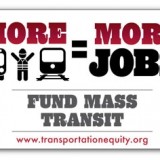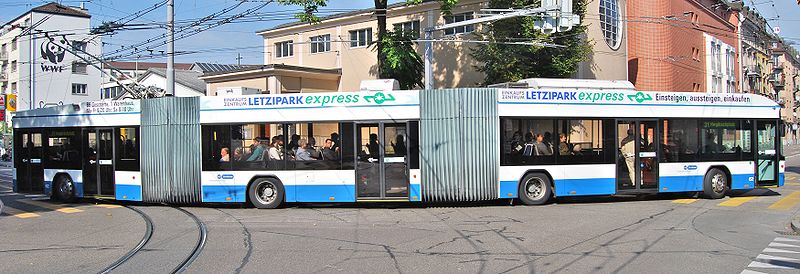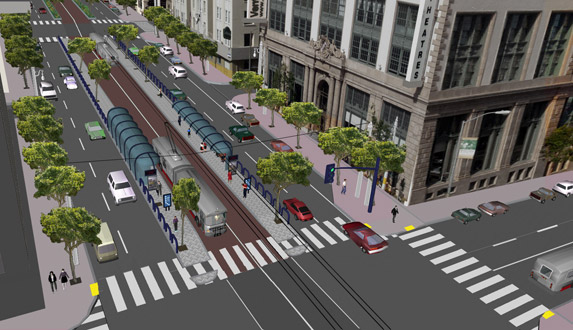Article by Brian Lewis in The Province. “Whatever the trucking industry wants in Delta, the trucking industry gets.
At least that’s how the community’s two MLAs see it after Delta’s municipal council quietly slipped through approval late this summer for Maersk Distribution, a division of one of the world’s largest shipping corporations, to launch a six-month pilot project utilizing extra-long trucking units — each about 30.5-metres long — to run from Deltaport’s container terminal to its centre on River Road.” Read article
Category Archives: Urban & Transport
Light rail to the valley
Story by CBC British Columbia. A new report says a light rail commuter line with 18 stops from Surrey to Chilliwack, B.C., would be an inexpensive way to beat traffic congestion in the Fraser Valley.
View story
Ancient history could be paved for South Fraser Perimeter Road
Article by Brian Lewis in The Province.
“This is the Glenrose Cannery archeological site in North Delta, where since 1969 scientists have dug deep into its earth and discovered artifacts and other remains that confirm that ancient First Nations peoples were using this location as a temporary summer food-gathering place as long as 9,000 years ago.
“It’s certainly one of B.C.’s oldest heritage sites and it’s also well known internationally in archeological circles, but as important and priceless as it is, that’s still not going to stop the B.C. government from building the $1.2-billion South Fraser Perimeter Road over it.”

Cut Freeway Spending to Create More Jobs
The
US-based Transportation Equity Network (TEN) recently released a
common sense proposal for creating jobs in the report More
Transit = More Jobs.
They look at what would happen if about half of the US urban freeway
budget was invested in public transit. Their answer is more jobs for
the same money.
TEN
emphasizes that public transit investment creates more jobs per
dollar than urban freeways and other roads. But they also propose
focusing more on immediate improvements to transit service rather
than resource intensive capital investments such as subway
construction as a way of boosting job creation: “Transit operations
generate more jobs per dollar spent than transit capital spending
because transit operations are more labor-intensive and do not
involve significant non-labor inputs, such as land acquisition or
materials.” This is a very important consideration here in BC,
where operating funds are so tight that Translink had to tie up one
of our three Sea Buses.
The
TEN study analyzed 20 US metropolitan areas and concluded that
shifting half of their highway funds to transit would result in a net
gain of 180, 000 jobs
over five years – with
no new spending. TEN
allies focus on the benefits of transit service,
rather than just the jobs, in promoting the plan to shift money away
from urban freeways.
More
jobs and improved transit for the same money sounds good, but there
are other much more important reasons to shift spending from roads to
transit. In Canada, transportation is the largest and fastest growing
source of the greenhouse gases that cause global warming.
Unemployment may be a serious problem, but the climate
crisis
threatens the very future of human society. As the old bumper sticker
puts it there are ‘No Jobs on a Dead Planet’. Perhaps it should
be updated to ‘No Jobs on a Cooked Planet’.
The
end
of cheap oil
is also a compelling reason to shift resources from freeways to
transit. The present economic crisis and resulting unemployment was
partly triggered by the sharp peak in oil prices in 2007 – 2008.
But this could just be the start of an oil price roller coaster as
oil supplies peak and go into decline. In the near future, oil
dependence could well be a recipe for economic ruin.
Perhaps
the biggest fault with the TEN study is that you could read it and
think that unemployment is the biggest threat to society, and that
peak oil and global warming are just additional reasons to support a
smart job creation strategy. The fact is that we will make big
changes, or circumstance will impose much harsher choices on us.
Given
the end of cheap oil and climate crisis, it is time for an end to
urban roadway expansion. Most of the existing roadway infrastructure
should be kept and maintained well, but the public money now spent on
roadway expansions must be reallocated to transit.
If
you agree that public funds should be shifted from urban freeways to
transit, please consider attending the 10/10/10
Dig in for Climate Justice
on Sunday October 10, 2010.
CBSA has decided to kill second train
Article by Matthew Buchanan for Transport Action BC. “According to Washington State Department of Transportation, the Canadian Border Services Agency has decided to impose an annual fee of $500,000 to recover the costs of border inspection for the second [Seattle-Vancouver] train. This will kill the second train which has been very popular since it was first introduced last year.” Read article
Vancouver Island Railway Study Released
Article by Matthew Buchanan on the Transport Action BC site. “The provincial study on the future of the Esquimalt and Nanaimo Railway… basically concludes that it is not worth investing any money in the railway corridor… The province, with help from the federal government will spend $1.184 billion on the South Fraser Perimeter Road (expressway). These road projects seem to get announced every week with no year-long half million dollar studies, but for non-highway projects the province isn’t interested in supporting them.” Read article
Highway jam enters its 9th day, spans 100 km
Article by Guo Qiang and Fang Yunyu in Global Times. “Traffic authorities were still struggling to cope with days-long congestion on a major national expressway, nine days after traffic slowed to a snail’s pace, and nearby residents are profiting on the latest traffic snarl by overcharging drivers for food.” Read article

Bus Rapid Transit hits the streets of NY: BC can do better
About 15 years ago one of the hot topics in the Vancouver papers was the plan for an at-grade light rail line from Coquitlam to UBC that would have taken up two lanes on Broadway and the Lougheed Highway. The plan was that rapid transit would connect Coquitlam and central Broadway within a few years. Shortly thereafter, the provincial government suddenly switched to a much more expensive – and never completed – SkyTrain line: today’s Millennium Line. Both Coquitlam and UBC are still waiting for rapid transit, and they may wait for decades, given the estimated $4.2 billion needed to connect both with SkyTrain on elevated guideways and subway tunnels.
The long-promised Evergreen Line SkyTrain branch to Coquitlam and the Northeast Sector is estimated at $1.4-billion but only $800 million has been committed by senior governments, leaving a $600 million gap. Translink is so strapped for cash that it was forced to mothball one of its three Sea Buses to reduce operating costs. The $2.8 billion estimated cost of extending the Millennium line to UBC is so daunting that it makes this funding gap insignificant.
In New York, the squeeze on the transit system is more intense. As transit ridership is growing rapidly, the aging subway system needs billions in upgrades, and even a modest extension to one line would cost billions they don’t have. But instead of crying about the expense of new subways, New York is putting rapid transit on the street with Bus Rapid Transit.
Bus Rapid Transit is a simple concept – you give buses a dramatic makeover that makes the rider experience much like rapid transit on rails but with a much lower capital cost. The main elements are dedicated lanes with enforcement to keep cars out, signal priority so buses seldom have to stop at traffic lights, and all-door boarding to reduce the time spent at stops. In Europe, many transit agencies no longer differentiate between Bus Rapid Transit and Light Rail lines. Bus Rapid transit is typically a bit faster than light rail, and has about the same maximum capacity. It can also greatly reduce operating costs as faster and larger buses carry more passengers per hour.
 The first full-featured Bus Rapid Transit lines were built in Curitiba, Brazil in the late 1970s, along rights of ways previously designated for freeways. But there are now hundreds of BRT lines around the world, including dozens in Europe and China. Los Angeles was an early adopter in North America with the Orange Line BRT. Ottawa also started a BRT line, but never completed the essential section into downtown because of reluctance to re-allocate street space to transit.
The first full-featured Bus Rapid Transit lines were built in Curitiba, Brazil in the late 1970s, along rights of ways previously designated for freeways. But there are now hundreds of BRT lines around the world, including dozens in Europe and China. Los Angeles was an early adopter in North America with the Orange Line BRT. Ottawa also started a BRT line, but never completed the essential section into downtown because of reluctance to re-allocate street space to transit.
Now New York is now leading the way in North America. The city is creating bus lanes on city streets for what they call Select Bus Service (SBS). The Bx12 line is the prime example, with the whole lane painted red to make it crystal clear that cars are not welcome. In June, the New York State Assembly passed a bill authorizing the transit agency to install digital video cameras on the front of BRT buses to photograph and ticket vehicles that intrude into bus lanes. Soon, every SBS bus driver will be able to document anything that gets in their lane, a powerful incentive for drivers to stay out of transit lanes.
The next step for New York is the 34th Avenue Transitway, with physically separated bus lanes, scheduled to open in 2012. But this line is not designed to be particularly rapid; it will stop far more frequently than a typical rail rapid transit line.
This is where Metro Vancouver could easily outdo New York. Our transit system is renowned for the B-line express buses that run on the same streets as local buses, but only stop every kilometre or so. ‘Rapid transit’ can only be rapid if it has widely spaced stops. Vancouver also has one of the largest fleets of electric trolley buses in the world, so upgrading to electric BRT would be easy and cost effective – we already have the trained technicians and maintenance equipment. On Hastings Street in Vancouver there is already a double set of wires in place, ready for express trolley buses.
 Translink’s 2006 cost estimate for high end Bus Rapid Transit on the Evergreen Line route was $384 million, less than a third of the cost of SkyTrain technology and less then half of the $800 million senior governments have already put on the table. SkyTrain would be perhaps five minutes faster, but could leave riders waiting for another 15 years or longer to get the financing in place.
Translink’s 2006 cost estimate for high end Bus Rapid Transit on the Evergreen Line route was $384 million, less than a third of the cost of SkyTrain technology and less then half of the $800 million senior governments have already put on the table. SkyTrain would be perhaps five minutes faster, but could leave riders waiting for another 15 years or longer to get the financing in place.
The same applies to all the rapid transit proposals around the province. The Broadway-UBC line in Vancouver, King George line in Surrey, and the Victoria to West Shore Line are all stalled for lack of funding. With electric Bus Rapid Transit, all of these lines could be operating within two years for a very reasonable cost. The provincial government plans to spend more money on one dubious urban freeway project than it would cost to build all these BRT lines. Cancelling the controversial South Fraser Perimeter Road freeway through Surrey and Delta would save about $2 billion. The rationale for the SFPR truck freeway – growing container imports from China – disappeared when container volumes dropped 19% in 2009.
What are we waiting for?

The addiction to growth
We humans, especially in the western world, have a commitment to growth
which, if sustained, will have disastrous results.
In fact growth is a
self fulfilling prophecy. For as fast as we expand to the outer limit,
that outer limit is handled by developers demanding and getting more
land to handle the growth, establishing yet another outer limit. That
can’t go on!
We seem to believe the old saw that if you don’t continue growing you
will go backwards into the maw of mediocrity. This mantra of “grow or
perish” spurs municipal politicians – where the real action is – to
attract more and more industry thus requiring more land for residences.
Even when land is kept away from developers, existing apartment space
will be forced to go higher.
Senior governments pitch in by building more highways and bridges which,
when built, will attract more and more vehicles.
We promise that we’ll stop using petroleum for fuel at the same time as
we develop more and more dirty oil and build new pipelines to transport
it.
More and more people, like me, write editorials and make speeches about
all this “progress”, more and more people agree and less and less is
done about it.
The new economic powerhouses in the world, India and China, (the latter
of which virtually owns the United States) will, as North America
increasingly depends upon them for goods, demand and get the US and
Canada to relax immigration laws – which we’ll have no choice but to accept
– and we’ll build more residences and highways to accommodate them.
Areas like the Downtown East Side in Vancouver will become more and more
crowded creating an ever increasing demand for more social housing.
We’re on a runaway train and don’t know how to get off.
The trouble with BC and indeed the country as a whole is that, by
international standards, we have plenty of space for more people to
occupy even considering the weather factor as you get into northern
regions.
How do we deal with this?
There us no magic bullet and people must start thinking – we all must
realize that development has become a Ponzi scheme where we need new
development to bring in new batches of capital with each new arrival
resulting in another new batch able to come in, and on it goes.
It all starts at the municipal level and that’s where we must make
our concerns felt.
Probe launched into university’s research funding
Article in The Province. “The president of Kwantlen Polytechnic University has launched a review of the school’s decision to accept a $50,000 research fee from the Century Group at the same time the school was promoting the controversial Southlands project it was researching.” Read article
Story in The Common Sense Canadian: University Gets Caught Lobbying for Developer – Now Wants to Investigate Itself
